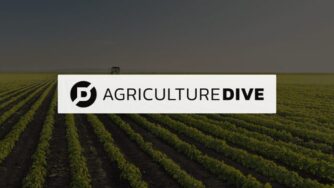View the full article in Investment Reports, Content Provider for Newsweek
What is the story behind CIBO and what role does the company play in the space of regenerative agriculture?
CIBO was formed by Flagship Pioneering in Cambridge, Massachusetts with the mission to use science and technology to understand agricultural systems at scale. Since launching in 2015, we have evolved to also drive change in farming practices that decrease greenhouse gas emissions and promote food systems resilience. Regenerative agriculture focuses on improving soil health and creating resiliency, while also reducing GHG emissions. Some example practices include crop rotation, low tillage farming, cover crops, reduced fertilizer application, and biological solutions that diminish the need for fertilizers or increase soil carbon. When consistently practiced, regenerative agriculture has been scientifically proven to increase farming profitability while decreasing the carbon footprint of operations and carbon intensity of the crop yield. This is good for farmers, the businesses that source crops, and the global climate.
CIBO has a portfolio of science-based technologies around the ability to model carbon and crop yield, use computer vision and remote sensing to understand the practices on the ground, and help growers qualify for carbon incentive programs. CIBO has a partnership with Dr. Bruno Basso, a world-renowned expert in agriculture and soil health at Michigan State University, who co-founded the company and still remains a valuable advisor today. In addition, the SALUS model that we use to do our crop yield and carbon modeling was developed and scaled by this academic institution.
How can your software help the fulfillment of regenerative agriculture and what are its main characteristics?
CIBO Impact is our software platform that allows growers or their trusted advisors to upload field boundaries in the program engine and instantly see programs and incentives for which they are eligible. These programs may be sponsored and funded by private companies in the form of scope-3 emissions reductions, carbon project developers, or by governments. Historically, understanding eligibility and potential returns required farmers to collect large amounts of historic practice data and go through a long process. We streamline this process by instantly giving farmers as much optionality and transparency as possible before they have to go through a full data collection and enrollment process.
Likewise, the food and ag industry is faced with hardships when delivering sustainability programs, scaling their enrollments, and trying to support emissions and carbon initiatives that often require multi-year management over millions of acres. With the help of our CIBO carbon and emissions models that give an overview of the present footprint against future practices, we solve issues at both the farmer and enterprise level. This wider view is extremely important for food companies that are engaged in Scope 3 projects and that need to have a grasp on the carbon footprint of their entire supply sheds. Our modeling solution is a ‘mechanistic crop model’ that actually grows a digital twin of the plant inside our computer model. By combining the practice data we detect from our satellite based computer vision with this crop modeling system, we are able to calculate carbon footprints and carbon intensity across a field, farm, county, or entire supply shed.
While sustainable farming is vital, profitability is also important for growers. How can your platform help reconcile these goals?
CIBO’s intention is to deploy the incentive programs in such a way that growers can obtain as many financial benefits per acre as possible.
When sustainable farming practices are adopted and implemented over time, both the science and real-world results demonstrate clear and consistent ROI on farming operations compared to conventional farming. However, the transition from conventional to regenerative can often be a challenge. By creating transparency to and optionality for incentive programs available to growers and their trusted advisors, we create an environment where growers can confidently adopt sustainable and emissions reducing practices without worrying that they’re betting the farm on a fad.
Our software is licensed on a white label basis to companies in the food and ag value chain. We see food companies, carbon project developers and governments being important program sponsors, and the input companies, commodities companies and coop/retail channels being important program delivery partners.
Besides your current U.S. footprint, do you also plan to expand into other markets in the future?
In addition to our U.S. presence, we have completed a number of proofs of concept and pilot programs internationally. Our models have been tested internationally, and in the future, we will expand to Europe and Latin America.
What are the main objectives that you would like to achieve at CIBO in the following years?
Our goal is to become the driving force and engine behind the transition to sustainable agriculture. We plan to remain an independent player that brings a strong impact to the world, but we are also interested in turning into a highly-valued company at the intersection of technology, agriculture and sustainability.



